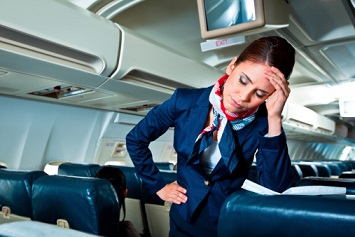Working as a flight crewmember can put a pregnancy at risk, particularly during the first trimester, notes the National Institute for Occupational Safety and Health (NIOSH). NIOSH points to three hazards that could imperil a pregnancy—circadian rhythm disruption (jet lag) or shiftwork, physical job demands, and cosmic ionizing radiation.
While pregnant workers in many occupations do shiftwork and heavy lifting, exposure to high levels of cosmic ionizing radiation is probably an occupational hazard that is unique to flight crews. The problem for pregnant flight attendants is that it cannot be avoided while flying.
What Is It?
Cosmic ionizing radiation comes from outer space with a very small amount reaching the earth. At flight altitudes, passengers and crewmembers are exposed to higher levels on every flight. The World Health Organization says that ionizing radiation causes cancer as well as reproductive problems, but NIOSH believes the issue warrants additional study.
“We don’t know what causes most health problems that could be linked to radiation, including some forms of cancer and reproductive health issues like miscarriage and birth defects,” states NIOSH. “If you are exposed to cosmic ionizing radiation and have these health problems, we can’t tell if it was caused by your work conditions or something else. We don’t know what levels of cosmic radiation are safe for every person.”
Unsafe Levels
Despite these reservations, NIOSH does not dismiss the risk. For example, one NIOSH study found that exposure to 0.36 millisievert (mSv) or more of cosmic radiation in the first trimester may be linked to an increased risk of miscarriage. If this estimated is accurate, the risk to flight crewmembers is high. The National Council on Radiation Protection and Measurements report that aircrew have the largest average annual effective dose (3.07 mSv) of all U.S. radiation-exposed workers. Other estimates of annual aircrew cosmic radiation exposure range from 0.2 to 5 mSv per year.
There are no official radiation dose limits for aircrew in the United States; however, there are national and international guidelines. For example, the International Commission on Radiological Protection (ICRP) recommends a dose limit of 20 mSv/year averaged over 5 years for radiation workers and 1 mSv/year for the public. For pregnant radiation workers, the ICRP recommends a dose limit of 1 mSv throughout pregnancy. The National Council on Radiation Protection and Measurements has a 0.5 mSv recommended monthly radiation limit during pregnancy.
Solar Particle Events
Flying through a solar particle event doesn’t happen often; pilots fly through about 6 solar particle events in an average 28-year career. Still, a pregnant crewmember who flies through a solar particle event can receive more radiation than is recommended during pregnancy by national and international agencies. Also, avoiding exposure to solar particle events is difficult because they often happen with little warning. One helpful resource is the National Aeronautics and Space Administration’s (NASA) Nowcast of Atmospheric Ionizing Radiation System ((NAIRAS), which was developed to report potentially harmful flight radiation levels to flight crews and passengers.
Recommendations
NIOSH says it recognizes that controlling one’s flight crew responsibilities to reduce exposure to high-altitude radiation is not a simple solution and one that can be constrained by job seniority, lifestyle, and personal issues. However, there are several actions pregnant crewmembers can consider:
- Try to reduce time working on very long flights, flights at high latitudes, or flights over the poles. Calculate usual cosmic radiation exposures. The Federal Aviation Administration has developed a tool to estimate the effective dose from galactic cosmic radiation (not solar particle events) for a flight (https://www.faa.gov/data_research/research/med_humanfacs/aeromedical/radiobiology/cari6).
- If pregnant or planning a pregnancy, consider work exposures, including cosmic radiation. If pregnant and aware of an ongoing solar particle event when scheduled to fly, consider trip-trading or other rescheduling actions if possible.
More information on the risks of cosmic ionizing radiation to pregnant flight crewmembers is at https://www.cdc.gov/niosh/topics/aircrew/reproductivehealth.html.

